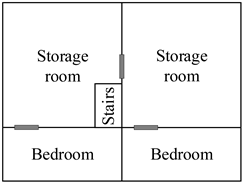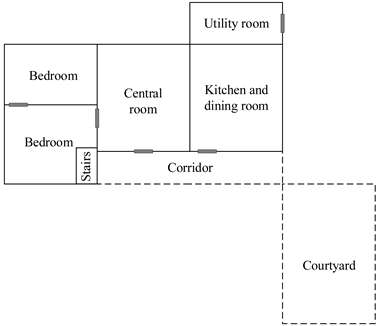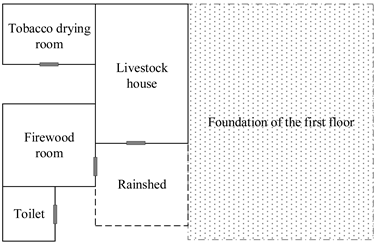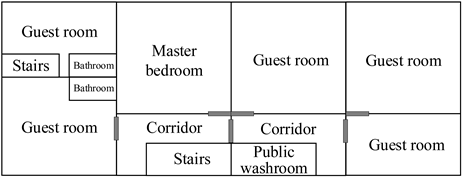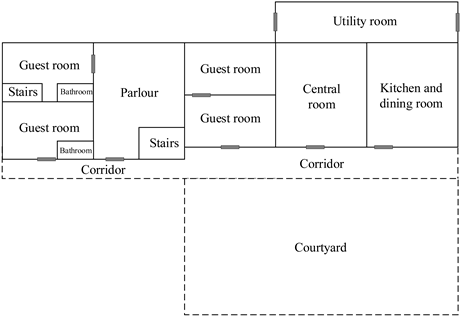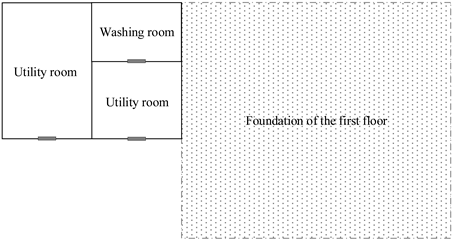Abstract
With the development of China’s national economy from the middle- and low-income stages to the middle- and high-income stages, the function of homesteads has undergone a significant evolution. Clarifying the evolution laws, characteristics, and dynamic mechanisms of various functions of homesteads can provide a basis for revitalizing the use of idle homesteads and promoting rural economic development. It can also provide theoretical guidance for implementing the Rural Revitalization Strategy. This paper uses statistical data and household survey data to establish a theoretical analytical framework for the functional evolution of rural homesteads under the background of changes in national economic-income levels. This study adopts comprehensive index model evaluation methods, participatory rural assessments, and participatory rural-mapping methods. This study reveals the characteristics and driving mechanism of the functional evolution of homesteads at different stages of economic development in China and verifies it from a microscale through typical rural homestay villages. The results show that the functional evolution of rural homesteads in China has apparent stages. In the middle- and low-income stages, the basic functions of the rural homestead are the living function, agricultural-production function, and social-security function. In the middle- and high-income stages, the living function, the nonagricultural-production function, and the asset function are the main functions. The functional evolution of rural homesteads is driven by both macro and micro factors. The multifunctional use of rural homesteads can fully activate the use rights of homesteads, realize the appreciation of the functional value of rural homestead assets, and provide primary power for rural social and economic development. Furthermore, it can play an essential role in China crossing the “middle-income trap”. The research results provide evidence for understanding the functional evolution law of rural homesteads and contribute to the rural geography of multifunctionality.
1. Introduction
In the process of economic globalization, rapid urbanization, and industrialization, the widening income gap between urban and rural areas and the decline in rural areas have become common problems and challenges worldwide [1]. As the largest developing country in the world, China has the largest number of villages and the largest rural population. The regional differences in rural areas are significant, and the situation is complex. How to achieve rural revitalization has become one of the most important tasks and challenges facing the Chinese government [2]. The multifunctional use of homesteads can effectively activate their right of use and promote the realization of the multiple values of rural homesteads, which is of great significance to the revitalization of rural areas [3]. At present, research on multiple functions of land use has become a frontier hot spot of land use/land cover change (LUCC) worldwide [4,5,6,7]. By the end of 2019, China’s rural permanent population was 551.62 million [8]. Rural homesteads are still an important part of rural land use in China. With national economic development from the middle- and low-income levels to the middle- and high-income levels, the migration of the rural population, the change in farmers’ livelihood sources, and the increasing demand of urban and rural residents for the functions of the homestead, the functions of the rural homestead have changed from the traditional basic function of living, agricultural production, and social security to the consumption function and value-added asset function of the commercial service industry [9].
Activating rural-land property rights and functions is the key content to revitalize the inefficient rural use of homesteads and realize rural revitalization [10]. The functional evolution of rural homesteads often corresponds to social and economic development, which is the response and embodiment of the changes in farmers’ livelihood and the evolution of the rural human–land relationship. Farmers have different needs for the structure and function of the homestead at different stages of social and economic development. The driving factors of evolution are affected not only by the social economy and farmers’ demand but also by the rural land system and policies [11,12]. At present, research on the functional evolution of rural homesteads has yielded rich results, mainly including the classification of rural-homestead function [3], the change in rural-homestead function [13], the multifunctional utilization of homesteads [14,15,16], the reform of homestead systems based on the functional perspective [17], the functional transition of homesteads [18,19,20,21], the withdrawal of homesteads based on the functional perspective [22], and the reuse of idle homesteads based on the functional perspective [23].
The homestead is a multifunctional complex space for the production, living, entertainment, and communication of rural residents [24]. The homestead is the core of the interaction and coupling of the human–land system in vast rural areas. It is the carrier for the rural population, social economy, and culture. It is also one of the most important land assets for rural households [25,26]. Since 1978, China implemented the reform and opening-up policy, and the diversity and complexity of rural-homestead utilization have gradually emerged. Affected by rapid urbanization and industrialization, the industrial structure in rural areas has undergone dramatic changes, which further promoted changes in the rural-homestead function. In addition, with the development of the rural economy and the improvement in farmers’ income level, farmers’ demand for homestead functions is also constantly changing [27]. In China’s eastern coastal areas, with a high degree of opening up and early industrial development, many rural homesteads are used to developing industries, commercial services, and other nonagricultural industries [10,28]. In the underdeveloped areas of Central and Western China, only the suburban areas and villages with better resource endowment can use homesteads and houses to develop nonagricultural industries, such as catering, agritainment, tourism, and homestay. Most ordinary villages are still dominated by living functions and agricultural-production functions [29,30]. Due to the duality of urban and rural land systems in China, there is a significant difference between rural-homestead-usage regulations and private-land-ownership countries. Before the “three rights separation” policy of homesteads was put forward, the multifunctional utilization of rural homesteads in China lacked a policy basis. In the process of a large number of rural people going out to work and moving to cities, many “hollow villages” [31] and idle homesteads were formed, which led to the waste of land resources and rural decline [32]. With the development of the social economy and urbanization in Europe and America, many rural residents migrate to cities to seek employment opportunities, resulting in a large amount of rural residential waste [33]. The multifunctional use of rural housing in foreign countries is less restricted by the land system. To alleviate the rural decline caused by the migration of rural residents to cities, Germany implemented the “rural residents plan” in the 1950s, allowing farmers to convert rural homesteads into farm hotels [34]. Other countries, such as the United States, Canada, Australia, Spain, and Israel, have also used rural homesteads for multifunctional use since the 1950s, mainly transforming them into multifunctional use for living, residence, and homestay. The multifunctional use of rural homesteads is affected by social and economic conditions and family development strategies. In 1994, the Ministry of Agriculture of Israel issued a policy to allow farmers to use homesteads and buildings for nonagricultural activities (mainly including housing rentals, tourism accommodations, leisure, and entertainment), which revitalized the declining rural areas [35].
China’s rural social economy is undergoing a transition from a traditional, small-scale, peasant economic society to an industrial society. People’s production and lifestyle have undergone tremendous changes, which has led to changes in people’s demand for land use and functions. Among them, rural homesteads’ functional requirements have changed significantly [36]. In different social and economic development stages, farmers’ livelihood strategies are different, and their functional demands for homesteads are also quite different. Therefore, a full understanding of the residents’ demand for rural-homestead function in different stages of social and economic development is conducive to the design and construction of farmers’ new villages and the transformation and utilization of homesteads and housing during the implementation of the Rural Revitalization Strategy. However, the current research on the relationship between the change in national economic-income level and the functional evolution of rural homesteads and microscale research on the functional evolution of rural homesteads based on homestay management is still relatively weak. Thus, we conducted an in-depth study on the evolution characteristics and dynamic mechanism of rural-homestead function after China transitioned from low-income countries to middle-income countries to provide a basis for revitalizing rural homesteads, activating the rural economy, and preventing China from sliding into the “middle-income trap”. At the same time, this study enriches the theory of rural-homestead function evolution and provides scientific guidance for village planning and rural-housing function design. Based on the analysis of the relationship between the stage change in national economic-income level and the functional evolution of rural homesteads, microresearch of typical homestay villages in hilly areas of Southwest China was conducted. We aim to explore the following three questions through quantitative analysis methods, participatory rural-assessment methods (PRAs), participatory mapping methods, and GIS technology:
- (1)
- What changes have occurred in the function of rural homesteads in China after the transition from the low–middle income level to the middle–high income level?
- (2)
- What are the driving factors of rural-homestead-function evolution at different income levels?
- (3)
- What are the policy implications for rural socioeconomic development and rural revitalization due to the evolution of rural-homestead functions caused by rural-tourism homestays?
2. Analytical Framework
Yi-Fu Tuan, a renowned geographer, believes that land use is a mirror of society, and the evolution of land use patterns and functions often corresponds to the development and change in the social economy [37,38]. We can promote the development of the social economy by controlling land use mode and function [39]. According to the World Bank’s “world development report 2019” classification criteria for per-capita gross national income (GNI), low-income countries are divided into USD 1025 per capita and below, lower-middle-income countries are divided into USD 1026–3995 per capita, the interval for upper-middle-income countries is USD 3996–12,375 per capita, and the interval for high-income countries is USD 12,376 and above per capita. In 2010, China’s per-capita GDP was USD 4340, which has entered the stage of development of a middle-income country from a low-income country (Figure 1). In the early stage of reform and opening up, China was a low-income country. With the rapid development of industrialization and urbanization, China achieved a leap from a low-income development stage to a middle-income development stage. At the same time, with the continuous development of the rural social economy and the increase in farmers’ savings, the functions of the rural homestead have changed from living and agricultural production to consumption and assets. When the per-capita gross national income is in the middle- and low-income stages, the functions of the rural homesteads are mainly agricultural-production functions, such as courtyard planting, livestock and poultry breeding, the primary processing of agricultural products, and the living function of farmers. When the per-capita gross national income reaches the level of middle-income countries, the functions of rural homesteads gradually transform into consumption functions and asset appreciation functions such as agritainment, catering, and homestays.
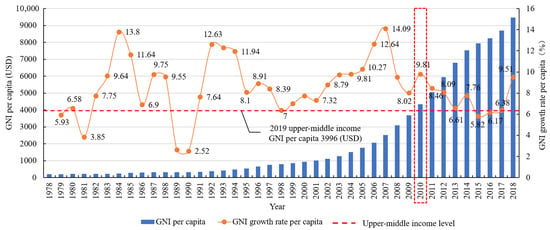
Figure 1.
Changes in per-capita gross national income and its growth rate since China’s reform and opening up. Data source: World Bank.
At present, the definition of rural homesteads can be divided into a broad sense and narrow sense: (1) The narrow sense of rural homesteads refers to the land used by rural residents for housing. (2) The broad sense of rural homesteads refers to the land used by rural residents for living and productive activities, that is, the land used by rural villagers for housing and buildings and facilities related to residential life, that is, land for housing and its necessary auxiliary facilities [40]. The study focus of this paper is rural homesteads in a broad sense.
The driving factors for changes in the national economic income level are extremely complex, with stage characteristics, and the corresponding rural-homestead functions also change accordingly. It should be noted that no matter which stage, the living function is the dominant function of the homesteads. (1) In the middle- and low-income stages, the main driving factors are China’s implementation of reform and opening up, the rapid progress of urbanization and industrialization, the implementation of economic system reform, and the adequate supply of the labor force. At this stage, rural homesteads in hilly and mountainous areas are still mainly based on traditional purposes—such as traditional ways of living, agricultural production, and social security purposes—which are providing farmers with basic daily living, grain storage, hand workshops, livestock, and poultry breeding, courtyard planting, etc. (2) In the middle- and high-income stages, the main driving factor is that after the financial crisis, the Chinese government implemented the “4 trillion plan” to expand domestic demand and promote steady economic growth. In addition, it has implemented major national strategic measures such as innovation-driven strategies, deepening rural-land-system reform, supply-side structural reform, and rural revitalization. At this stage, the leading functions of rural homesteads have been transformed into functions focusing on the living function, nonagricultural-production functions (such as agritainment, homestay, etc.), and asset value-added functions (Figure 2).
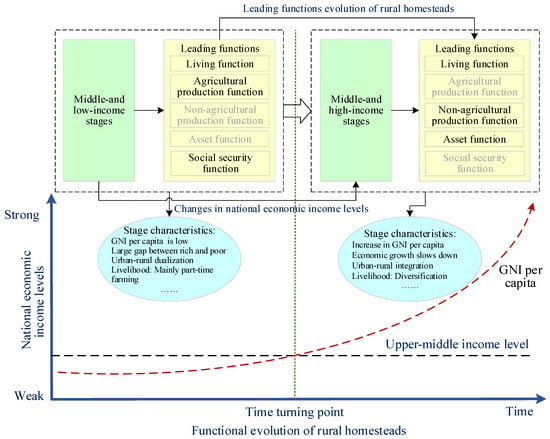
Figure 2.
The analytical framework of rural-homestead functions evolution under the background of national economic-income-level change.
Both macro background and microenvironment influence the functional evolution of rural homesteads. The macro background is often characterized by common features, such as the stage of national economic development, the income gap between urban and rural areas, nonagricultural employment opportunities, and public services. However, the microenvironment is generally different, which also conforms to the regional differentiation rules in the classical geography theory, such as village resource endowment, farmers’ livelihood strategy, and specific rural land policies, which impact the functional evolution of rural homesteads. Macroscale research can reveal the overall evolution law of Chinese homestead function and provide strategic guidance for rural land use, while microscale research can verify the evolution process of macroscale homestead function through typical cases, and reveal the evolution law and driving factors at the micro level. Therefore, it is necessary to explore the functional evolution of rural homesteads from the macroscale external environment and the microscale of the village area.
3. Materials and Methods
3.1. Data Sources and Processing
3.1.1. Data Sources
The data used in this paper include statistical yearbook data, national rural fixed observation point survey data, field survey data, and Google Earth high-definition remote-sensing images, including the following aspects: (1) socioeconomic data, mainly from the “China statistical yearbook”, “national rural fixed observation point survey data collection”, “statistical bulletin on the development of human resources and social security” and the socioeconomic statistical data provided by the village committee of the case areas. (2) Land use data, mainly through remote-sensing interpretation and field surveys. (3) The data on the functional evolution of rural homesteads were obtained by semistructured interviews, questionnaire surveys, and photo-taking in August 2020. (4) Remote-sensing image data come from Google Earth.
In the field research, the semistructured interview method of participatory rural assessment (PRA) was used to conduct in-depth interviews with the directors of the village committee, farmers, village heads, villagers who are familiar with the situation of the village, and experts in the planning and design of the homestay project. We obtained the social and economic conditions, the source of farmers’ livelihoods, and the functional evolution data of the rural homesteads before and after operating a homestay of Xiniu village at various stages. The specific contents of the survey are desribed as follows: (1) The basic characteristics of farmers, including the data of farmers’ population, sources of livelihood, nonagricultural employment time, family income, and expenditure. (2) The homestead evolution data, including the homestead location, housing construction time, housing area, housing structure and function, building materials, and housing floors data at various stages. (3) The operation status of the homestays.
3.1.2. Socioeconomic Data Processing
The socioeconomic data involved in this study are from 1995 to 2015. Due to the long period, to ensure the accuracy and comparability of economic data, we need to select a specific year as the base year, consider the inflation rate, and unify the economic data of other years to the inflation rate standard of the base year. To solve this problem, this paper introduces the concepts of comparable prices and comparable growth rates in economics [41] and determines 1995 as the base year to convert the economic data from 1996 to 2015. The inflation rate is the rate of change in the current year’s price level relative to the previous year’s price level, calculated using Formula (1):
In the formula, is the inflation rate, is the price level in year , and is the price level in year .
Since 1995 is determined as the base year, and the inflation rate is the rate of change relative to the previous year, it is also necessary to convert the inflation rate using the base year as the standard. Let the inflation rate in 1995 be 1, and use Formula (2) to calculate the inflation rate in the remaining years relative to 1995:
In the formula, is the inflation rate relative to the base year, is the new inflation rate, such as 1 in 1996 and in 1997, and is the original inflation rate.
In Formula (3), is the economic index value of the current year after conversion, is the economic index value of the current year, and is the inflation rate relative to the base year.
3.2. Methods
3.2.1. Selection of the Evaluation Indicators
The functional evolution of rural homesteads is significantly affected by social and economic development, farmers’ livelihoods, and policies. Referring to the existing related results, this study divides the functions of rural homesteads into living functions, agricultural-production functions, nonagricultural-production functions, asset functions, and social-security functions. According to the principles of data availability and scientific nature, 16 indicators are selected to construct the evaluation indicator system of the coupling relationship between rural-homestead function evolution and economic development level and to explore the relationship between the five functions of the rural homestead and economic development level (Table 1).

Table 1.
Coupling evaluation indicator system of rural-homestead function evolution and economic development level.
Because of the significant difference in the dimension and order of magnitude of the evaluation indicators, it is impossible to calculate and compare them directly. In this paper, the range standardization method is adopted to standardize the indicator values (Formula (4)).
In the formula, is the number of years, is the number of indicators, represents the standardized value of the indicator in the year, represents the original value of the indicator in the year, and and are the maximum and minimum values of the indicator, respectively. Considering the objectivity of the results, this paper uses the entropy weight method to determine the weight of each indicator. To meet the requirement of logarithm calculation by the entropy weight method, it is necessary to translate the normalized value of the indicators (Formula (5)).
Calculate the entropy value of the indicator (Formula (6)):
Calculate the weight of the indicator (Formula (7)):
3.2.2. Construction of the Comprehensive Index Model
The comprehensive index model is one of the comprehensive evaluation methods in which the indicator data are dimensionlessly processed, and corresponding weights are assigned to obtain the comprehensive index through weighted calculation. The calculation formula is defined as follows (Formula (8)):
In the formula, is the comprehensive evaluation value, is the evaluation indicator, is the dimensionless value of the evaluation indicator, and is the evaluation indicator weight.
By calculating the living-function index, agricultural-production function index, nonagricultural-production function index, asset function index, social-security function index, and comprehensive index of the economic-development level of rural homesteads in the study period, the changes in various indexes are used to reflect the changes in homestead functions and socioeconomic development.
3.3. Study Area
Xiniu village is located in the north of Tudi Township, Wulong District, Chongqing. It is located in 107°52′–107°53′ E and 29°32′–29°33′ N. This village belongs to the typical hilly landform. The land-use types are mainly rural homestead, cultivated land, forestland, and natural reserve land (Figure 3). The village has abundant tourism resources, including Karst Cave, Stone Forest, Natural Bridge, Welcoming Pine, and Yancang River, which are perfect places for leisure, tourism, and vacation, outdoor sports, and adventure and entertainment and known as “pure land on earth, blessed ecological land”. This village is an important part of the Fairy Mountain National Forest Park 5A grade tourist scenic spot. It is away from the large-scale real landscape performance theater of “impression of Wulong” 4 km, 5 km away from the world natural heritage site and national 5A scenic spot, Three Natural Bridges, and the Fairy Lake. In 2019, there were 42 households and 180 people in the village, including 37 people under 17 years old, accounting for 20.56% of the total population, 76 people aged 17~35 years old, accounting for 42.22% of the total population, 36 people aged 36~60 years old, accounting for 20.00% of the total population, and 31 people aged 60 years old and above, accounting for 17.22% of the total population. The average net household income of the village in 2019 is 50,000 CNY/year. The nonagricultural-income increase channel for farmers is mainly to use homesteads to develop rural tourism and homestays. Agricultural products are mainly planted with a small amount of corn, potatoes, and other food crops.
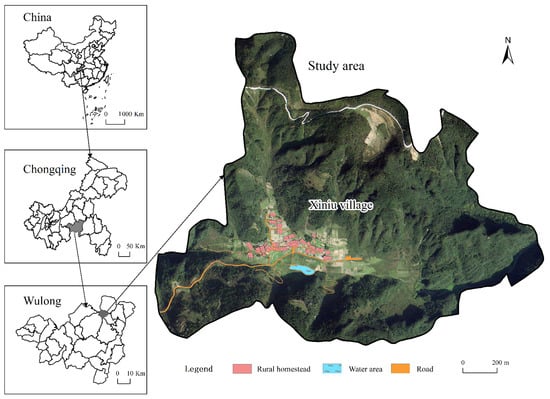
Figure 3.
Location of the study area.
This paper selects Xiniu village as the microscale empirical case area for the following reasons: (1) Xiniu village is located at the junction of Wuling Mountain and Dalou Mountain. The village is located on the tourist ring of Houping Tiankeng, Three Natural Bridges of the World Natural Heritage. The village is 60 km away from the residence of the Wulong district government station. The landform type is mainly hilly. The altitude of the village is 850–900 m. Affected by urbanization, many young and middle-aged laborers went out to work, which led the village to be on the verge of decline. Relying on good natural resources, after using rural homesteads to develop homestay, it attracted farmers to return home to develop homestay and realized the transformation from a traditional agricultural village to a tourist homestay village. The village is a rural-homestead function from the perspective of homestay management in hilly areas, and it is a typical representative of evolution research. (2) The village is a typical homestay village. The livelihood of farmers has changed from traditional agricultural production and migrant workers to the operation of homestays. Correspondingly, the function of rural homesteads has also changed from living and agricultural production to consumption and asset appreciation. This area is a rare case area. (3) Xiniu village is the most complete traditional, ancient village in Chongqing. All the houses of the farmers are wooden buildings with prominent ethnic–cultural characteristics.
4. Results
4.1. Functional Evolution of Rural Homesteads Based on the Macroscale
4.1.1. Evaluation Results and Overall Characteristics of Rural-Homestead Function Evolution
According to Formula (4), the indicators of various functions and economic-development levels of the rural homestead from 1995 to 2015 are dimensionlessly processed by the extreme value standardization method. The quantification table of evaluation data in the study period can be obtained. Then, the entropy weight method is used to calculate the weight of each index. According to Formula (6), the living-function index, agricultural-production function index, nonagricultural-production function index, asset function index, social-security function index, and a comprehensive index of economic development level are calculated (Table 2).

Table 2.
Comprehensive evaluation results of rural-homestead functions and economic development level.
China’s economic development presents a “sustained growth” trend in the study period. From the perspective of growth rate, it can be divided into two apparent stages, that is, the slow growth stage from 1995 to 2009, with the index value of 0–0.59, and the rapid growth stage from 2010 to 2015, with the index value of 0.60–0.99, which corresponds to the point made in Section 2 of the paper that China’s economic development moved from the “middle- and low-income stages” to the “middle- and high-income stages” in 2010. Social and economic development has a strong impact on the functions of rural homesteads, the most significant of which are the living function and social-security function. The other three functions are similar to the overall trend in social and economic development (Figure 4).
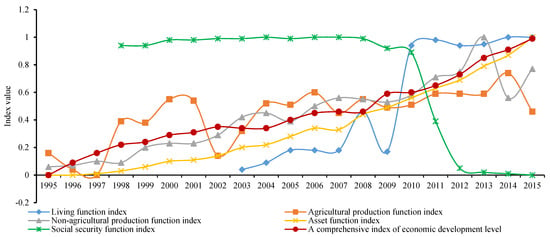
Figure 4.
The evolution of rural-homestead function and the composite index of economic-development level from 1995 to 2015 in China.
- (1)
- The evolution of the living function of rural homesteads showed slow growth before 2007, and its index value was 0.14–0.18 from 2003 to 2007. There was a large fluctuation between 2007 and 2010, and the index value decreased from 0.18 to 0.17 and then increased to 0.94, showing an “N”-shaped fluctuation trend. In addition, it showed a slow-growth trend after 2010, and the index value was 0.94–1 from 2010 to 2015. Notably, the living function maintained a relatively stable development trend before and after the “N”-shaped fluctuations, but there were large fluctuations between 2007 and 2010. The main reason is that the global financial crisis broke out in 2008. In the “troika (investment, consumption, export)” driving economic development, China relied too much on investment and exports. When the financial crisis broke out, and external demand decreased, exports were severely tested, and the national economy development was hindered. However, many migrant workers in China are mainly concentrated in the eastern coastal areas. Many enterprises and factories have been suspended due to the severe impact of the financial crisis. These suspensions have caused many migrant workers to lose their jobs and return to their hometowns. Most farmers have some savings due to years of work and just use the low-cost building materials promoted by the economic downturn to upgrade or build new houses. The main purpose is to improve living conditions and ultimately lead to a substantial increase in the living functions of rural homesteads compared to the previous stage.
- (2)
- The evolution of the social-security function of the homestead maintained stable development before 2010, with a high index value of 0.89–1 from 1998 to 2010, indicating that the social-security function has a high degree of importance in various functions. From 2010 to 2012, the index value dropped sharply from 0.89 to 0.05. After 2012, the value maintained stable development, with a low index value. The index value from 2012 to 2015 was 0.05 to 0, which indicates that the social-security function of the homestead was significantly weakened. The overall characteristics show that the social-security function of the homestead is strong in the middle- and low-income stages and maintains stable development, while it decreases rapidly and maintains stable development after entering the middle- and high-income stages. With the development of the social economy and the continuous improvement in the national social-security system, China began to implement the new rural social endowment insurance pilot in 2010. At the end of the year, the number of people participating in rural endowment insurance was 86.91 million, an increase of 30.96 million compared with the previous year. Due to the continuous improvement in the rural social security system, the social-security function of rural homesteads gradually weakened.
- (3)
- The evolution of the agricultural-production function of homesteads shows a “long-term fluctuating” trend; before 2009, the index fluctuated wildly, ranging from 0.16 to 0.6 from 1995 to 2009. From 2010 to 2013, the index maintained stable development, with index values between 0.51 and 0.59. After 2014, the value decreased sharply, with the index value decreasing from 0.74 in 2014 to 0.46 in 2015. Generally, the agricultural-production function of homesteads showed a “slow fluctuating growth” before 2011 and a weakening trend after 2011. The agricultural-production function of the rural homestead is mainly reflected in farmers’ use of homesteads for breeding, including pigs, cattle, sheep, chickens, ducks, and other livestock, some of which are used for their consumption, most of which are put on the market, which is an important part of farmers’ livelihood. However, due to the impact of diseases and the market, the function shows a significant fluctuation trend, but since 2006, it has shown a slow declining situation. The main reason is the evolution of farmers’ livelihood strategy and social division of labor in rural areas. Many farmers go out to work, and the left-behind elderly and children are less likely or no longer carry out livestock- and poultry-breeding activities and are replaced by livestock farms.
- (4)
- The evolution of the nonagricultural-production function of the homestead showed a trend of “small fluctuations in sustained growth” from 1995 to 2010, and its index value was between 0.06 and 0.58. Between 2010 and 2015, the index value increased from 0.58 to 1 and then decreased to 0.77, showing a “rapid growth N-shaped fluctuation” trend. The overall characteristic is sustained growth, but after 2010, the index rapidly grew. The nonagricultural-production function of homesteads mainly refers to the use of homesteads and housing to operate shops, restaurants, agritainment, hotels, homestays, and other commercial service activities, which is mainly affected by the policy of homestead utilization and social and economic factors. When the national economy is in low-income development, farmers are attached to the land and take agriculture and part-time workers as the source of livelihood, and the nonagricultural-production function of homesteads lacks the environment for development. With the development of the social economy and the diversified development of urban and rural residents’ consumption, the Chinese government has issued several policies to encourage farmers to use idle homesteads to develop agritainment and homestay. In August 2015, the Ministry of Agriculture, together with the National Development and Reform Commission and 11 other departments, jointly issued the “Notice on Actively Exploiting Multiple Functions of Agriculture and Vigorously Promoting the Development of Leisure Agriculture”. This supported the use of surplus construction land in idle-homestead consolidation, idle collective-construction land in the village, and “four wastelands” to develop agritainment. Under the background of the rapid development of the social economy, the transition of residents’ consumption structure, and the favorable policies of the country’s multifunctional use of rural land, the nonagricultural-production functions of rural homesteads have been further developed.
- (5)
- The evolution of the asset function of homesteads shows a trend of “sustained and stable growth”, with a very small fluctuation. There was an obvious turning point in 2008, with the index value rising from 0 to 0.33 from 1995 to 2007, and the index value increasing significantly from 0.44 in 2008 to 1 in 2015 from 2008 to 2015, indicating that the function of homestead assets has been significantly improved after 2008. With the rapid expansion in urban land, many rural land resources have been expropriated as state-owned, and the contradiction between the supply and demand of urban and rural construction land has become increasingly prominent. In this context, the state has begun to explore the long-term mechanism to revitalize rural, idle land resources and has made substantial progress. Policies such as “linking the decrease in rural construction land with the increase in urban construction land, Chongqing land ticket system, the entry of collective operating construction land into the market” have contributed to the continuous increase in the asset value of rural homesteads and the continuous increase in asset functions.
4.1.2. Functional Evolution Characteristics of Rural Homesteads in the Middle- and Low-Income Stages
At the end of the 1970s and the beginning of the 1980s, China implemented the policy of internal reform and opening to the outside world. Since then, China has entered the stage of rapid urbanization and industrialization, which dramatically impacted cities and rural areas. In November 1978, Xiaogang village, Fengyang County, and Anhui Province began to implement the “rural household contract responsibility system”, which opened the curtain of China’s rural reform and then established the socialist market economic system, which promoted China’s social and economic development into a new period. According to the analysis in Section 2 of the paper, from the reform and opening up to 2010, China’s economic development level belongs to the stage of the low-income level. The country’s input of resource elements focuses on cities, while the development of rural areas is relatively slow. Economic development is still dominated by the primary industry, most of the farmers are attached to the land, and the livelihood of farmers is mainly agricultural production and migrant workers. In addition, at this stage, the ability of migrant farmers to settle down in the city is weak, and there is less social security in rural areas, so the social-security function of the homestead for farmers is particularly important. Under the primary industry background and insufficient social-security capacity in rural areas, farmers’ functional demand for rural homesteads and residential design naturally coincides with daily agricultural production and living. The functions of rural homesteads in the middle- and low-income stages are mainly living functions, agricultural-production functions, and social-security functions, while nonagricultural-production functions and asset functions are weaker.
4.1.3. Functional Evolution Characteristics of Rural Homesteads in the Middle- and High-Income Stages
Since China’s economic development entered the middle- and high-income stages in 2010, among the five functions of rural homesteads, except for the gradual weakening in the agricultural-production function and social-security function, the living function, nonagricultural-production function, and asset function have been strengthened. The agricultural-production function of the homesteads maintained steady development after 2010 and weakened in 2015. The agricultural-production function is the traditional and basic function of the homestead, mainly for farmers to achieve self-sufficiency of meat, eggs, poultry, vegetables, and other production by using the breeding-land space of the homestead. Of course, the surplus is also put on the market. As the degree of nonagriculturalization of farmers’ livelihood sources has increased, the agricultural-production function of homesteads has weakened, but the extent of the weakening is relatively small. The social-security function of homesteads weakened rapidly after 2010. The main reason is that after 2010, the rural social-security system strengthened, and rural endowment insurance and new rural cooperative medical insurance were realized, which led to the weakening in the social-security function of the homestead. After 2010, the living function of the homestead was operating smoothly. As the living function is the most fundamental function, it does not change significantly once it is systematically updated. The nonagricultural-production function of the homestead has increased rapidly after 2010, accompanied by volatility, which indicates that the use of homesteads to carry out catering, workshop production, and service activities by farmers has increased significantly. The main reason is that since 2009, the relevant departments of the state have issued many policy documents to promote the development of rural tourism and leisure agriculture, which combine new rural construction with rural tourism and promote the development of rural tourism. This action also sets up leisure farms, agritainment, and homestays and encourages the use of homesteads to develop nonagricultural-production activities. In addition, the PPP (public–private partnership) model and the “Internet + leisure agriculture model” are introduced into the development of leisure agriculture so that the nonagricultural-production function of homesteads is significantly enhanced. The turning point of the asset function of the homestead was in 2008, two years earlier than the national economy entering the middle- and high-income stage. Because the homestead is a scarce resource, its asset function is different from other functions, and it is greatly affected by the rural-land-use policy and the land market. As early as 2005, several rural-land-use policies were issued to explore the revitalization and utilization of idle rural-land resources, thereby promoting the development of the function of homestead assets to be significantly enhanced after 2008.
4.2. Functional Evolution of Homesteads in Homestay Villages Based on Microscale
4.2.1. Structural and Functional Characteristics of Homesteads before Operating the Homestay
The Tujia stilted building of Xiniu village has a long history. It follows the slope and takes local materials, partly built on the ground, partly overhanging. They are mainly constructed with wood, stone, rammed earth, and blue tiles. Young and middle-aged people left the village due to the village’s remote location and inconvenient transportation. Some houses were left idle and abandoned, the infrastructure was backward, and the population was severely aging, which became typical characteristics of a “declining village”. Some migrant workers bought houses and settled in the city but did not return home to build houses so that the original Tujia “column and tie structure style” stilted building was preserved entirely, which laid the foundation for the village to be selected as “Chinese traditional ancient village” and the use of homestead and residential development of rural tourism. Before developing rural homestays, the structure and function of rural homesteads were mainly to serve the living and agricultural production of farmers in Xiniu village (Table 3).

Table 3.
The internal structure and function of the homestead before the operation of homestay in Xiniu village.
The spaces under the ground floor are mostly livestock houses. In addition, there are tobacco-drying rooms, firewood rooms, and toilets. The other part is the foundation of the first floor.
The ground floor is divided into two parts: the overhanging part of the main room and the field part. The overhanging part of the ground floor is the bedroom, which mainly prevents the adverse effects of excessive moisture on the body in the field. The ground floor is mostly the main room and the kitchen, which is generally equipped with a firepit for smoked bacon in winter. The kitchen is usually a wing room or a side room built beside the main room, usually with only one floor, which is shorter than the main room.
The first floor is usually called garret, and generally, only the main room has the first floor. There are two small bedrooms in front of the house, and the rest are the space for storing food (Figure 5).
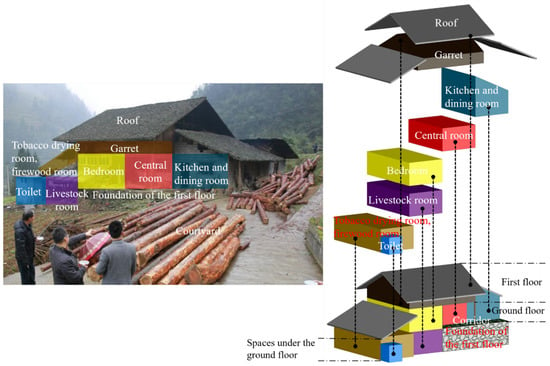
Figure 5.
The internal land use and spatial structure of homesteads before the operation of homestays in Xiniu village.
4.2.2. Structural and Functional Characteristics of Homesteads after Operating the Homestay
In 2014, with the joint participation of the Wulong District Housing and Urban-Rural Construction Committee, the Tudi township government, village leaders, and farmers, ancient village houses were transformed using local building materials and traditional technologies, realizing the inheritance and protection of Tujia stilted buildings. Based on this, farmers use their homesteads to develop rural homestays, which have achieved poverty alleviation and prosperity and rural revitalization. After developing rural tourism and homestay, the utilization of homesteads has changed significantly, mainly in the expansion of land use space and the change in internal land structure and function. In addition, the industrial form has changed significantly, from agriculture and migrant workers to tourism and homestay services. In contrast, in the aspect of agriculture, only the food materials needed for rural tourism catering are mainly produced, and the quantity is small, so livestock- and poultry-breeding activities are no longer carried out (Table 4).

Table 4.
The internal structure and function of the homestead after the operation of the homestay in Xiniu village.
The spaces under the ground floor are transformed from the original livestock room to the utility room. As livestock and poultry breeding and tobacco planting are no longer carried out, the original tobacco-drying room and firewood room have changed into the washing room and utility room. The original dry toilets were demolished, and all of them were transformed into washrooms. In general, the hanging foot space under the main room of the first floor was transformed into a washing room and utility room, and a new building space was added to the original tobacco-drying room and firewood room.
The ground floor has been expanded from the original two main rooms, a kitchen, and a utility room to four main rooms, a kitchen, and two utility rooms, and the courtyard in front of the house has been expanded. The newly added building space has two guest rooms. The original master bedroom was transformed into a parlor and stairs. The original central room was transformed into two guest rooms. The original kitchen was transformed into the main room as a new central room. A new kitchen was added to the right side of the main house, and a utility room was added to the back. There are corridors in front of all the houses on the ground floor. The corridor near the dining room and the central room is relatively spacious and is mainly used for setting tables and dining for tourists. In addition, the courtyard was expanded, occupying part of cultivated land, mainly to increase parking spaces.
The first floor has evolved from two storage rooms and two small bedrooms in the original two main rooms into five guest rooms and one master bedroom in the four main rooms, and the rest of the space is a corridor, stairs, and a public washroom. Due to the homestay development, most of the corn, potatoes, and vegetables are consumed during the tourists’ visits, and no more livestock and poultry are raised. There is no need to store more feed and grain. Therefore, all the original storage rooms have been transformed into guest rooms for tourists’ accommodation (Figure 6).
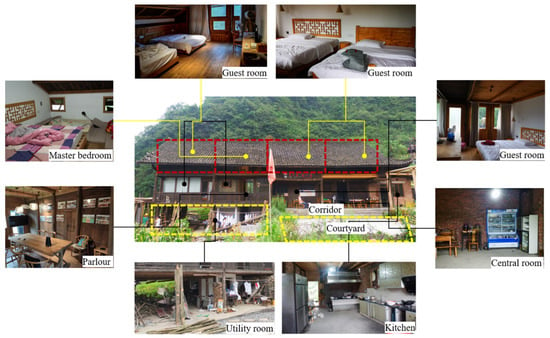
Figure 6.
The internal structure and functional layout of the homestead after the operation of the homestay in Xiniu village.
5. Discussion
5.1. The Functional Evolution of Homesteads under the Background of Economic Development on the Macroscale Can Reflect Its Overall Trend
Social and economic development promotes the transition of rural homestead utilization from a single function to multiple functions. The functional evolution of rural homesteads is an important representation of social and economic transition development. Exploring the trend and characteristics of rural-homestead function evolution under the background of economic transition development helps the country manage and regulate the multifunctional utilization of rural homesteads at the macrolevel [2,42]. Since China’s reform and opening up, its economic development has made remarkable achievements. The per-capita national economic income increased from USD 200 in 1978 to USD 9470 in 2018. China’s economic development in 2010 moved from the middle- and low-income stage to the middle- and high-income stage. With the expansion of cities and towns, the diversification of farmers’ demand for homestead function, the enhancement in farmers’ demand for improving the living conditions, the growth of urban residents’ demand for rural tourism, and the national policy preference for leisure agriculture and rural tourism, the structure and function of rural homesteads show the characteristics of diversification, complexity, and differentiation. In addition, due to the implementation of the “urban-rural dual” land system in China, urban residents are forbidden to buy homesteads and housing in rural areas and can only operate through means such as leasing, joint operation, or becoming a shareholder. Therefore, the multifunctional utilization of rural homesteads in China is more complicated than that in Western countries [18]. The evolution law of the multifunctional utilization of rural homesteads in China is transforming from the basic functions of living function, agricultural-production function, and social-security function to the function of living function, nonagricultural-production functions (such as shopping, catering, farmhouse entertainment, homestay, etc.) and asset function (Figure 7). The function evolution of rural homesteads is affected by many complex factors. In addition to the main factors, such as socioeconomic development and farmers’ livelihood needs, the establishment of the “three rights separation” policy of rural homesteads is also an important factor. Based on fully guaranteeing the homestead qualification rights of farmers, the property income function of homesteads and houses has been further enhanced through the multifunctional use of homesteads (this mainly refers to nonagricultural production and operation activities of homesteads, such as independent operation, cooperative operation of agritainment, homestays, and rural tourism), which is of great significance to effectively revitalize idle rural homesteads and rural revitalization.
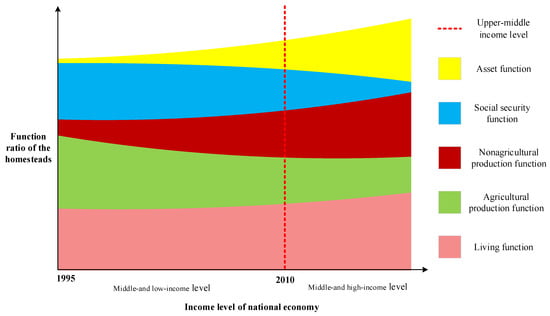
Figure 7.
Evolutionary Trend in Homestead Function under the Background of Economic Development.
5.2. The Functional Evolution of Homesteads at the Homestay Village Based on the Microscale Can Be Used to Verify the Results of the Macroscale Evolution
The multifunctional use of rural homesteads in China presents a certain evolution law on the macroscale. However, due to China’s vast territory, the resource endowment of villages in different regions is quite different, and even different villages in the same region are quite different. The time node of the functional evolution may be earlier or later than those of the macroscale. Therefore, it is necessary to carry out a multifunctional-utilization-evolution analysis of rural homesteads according to the types and resource endowments of different villages. With the development of China’s social economy from the middle- and low-income stage to the middle- and high-income stage in 2010, the demand for rural tourism has been increasing. Moreover, the central and local governments have issued many policies and measures to encourage the development of leisure agriculture and rural tourism, which has significantly enhanced the consumption function of rural homesteads, including rural tourism, homestay, and agritainment. The structural and functional evolution of rural homesteads and housing in Xiniu village is a typical epitome of the functional evolution of rural homesteads in China under the background of social and economic transition. The development of rural homestays in the village is based on the spatial optimization and structural and functional renewal of the original homestead and houses. This homestay is different from urban homestays and rural homestays with commercial operations. This homestay has a strong representation in the study of the functional evolution of rural homesteads. The significant evolution of the rural-homestead function occurred in 2014, with a lag of four years compared with the time node when China’s social economy entered the middle- and high-income stage in 2010. This result indicates that the response of remote rural social and economic development to national economic development has a certain lag, which is in line with the basic common sense and law. Before developing rural tourism and homestays, Xiniu village mainly experienced two stages: the first stage was to make a living by agricultural production before 2000, and the second stage was that a large number of the middle-aged labor force went out as migrant workers after 2000. Correspondingly, before 2000, the main functions of the rural homestead were living function, agricultural-production function, and social-security function, while the asset function and nonagricultural-production function were weak. After 2000, due to the part-time livelihood of farmers, some farmers went out as migrant workers, and the homesteads and houses were idle and dilapidated, resulting in the apparent weakening of various functions of the homesteads. According to field research, after the development of rural tourism and homestays in Xiniu village in 2014, the village infrastructure has been improved, the homestead and house structure have been renovated, and the functions have been updated, showing an opposite functional state from the previous stage. Among them, the most significant evolutionary feature is that the nonagricultural-production functions and asset functions of homesteads have been significantly enhanced, the living and residential space has been compressed, but its functions have been enhanced, the agricultural-production functions have been significantly weakened or have even disappeared, and the social-security functions have been continuously weakened.
The driving factors for the significant evolution of the rural-homestead structure and function of Xiniu village are more complex, including macroscale socioeconomic and policy factors and microscale factors such as village resource endowment and architectural style. In the process of rapid urbanization and industrialization, national economic development has moved from the middle- and low-income stage to middle- and high-income stage. At the same time, the Party Central Committee has proposed major measures such as rural revitalization strategies and targeted poverty alleviation to promote rural social and economic development. The livelihood of farmers in this village has changed from farming and going out as migrant workers to developing tourism, homestays, and other commercial and service industries. Infrastructure and transportation accessibility have significantly increased, the quality of the living environment has continuously improved, and poverty has been lifted. Based on the “three rights separation” policy of rural homesteads, the Chinese government has issued several land-use policies to encourage farmers to use idle homesteads and housing to develop tertiary industries such as homestays. Xiniu village combines the inheritance and protection of traditional ancient villages, architectural styles, and architectural techniques to develop rural homestays, which makes the dominant function of homestead change from living function, agricultural-production function, and social-security function to nonagricultural-production function and asset function (Figure 8).
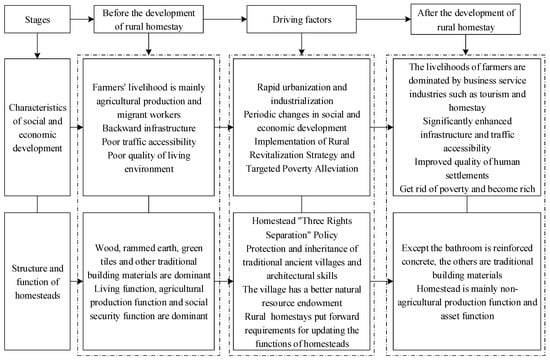
Figure 8.
Dynamic mechanism of rural homesteads function evolution in Xiniu Village.
5.3. Multifunctional Use of Rural Homesteads Can Contribute to China’s Escaping from the “Middle-Income Trap”
The “middle-income trap” includes the development system trap, social-crisis trap, and technology trap [43]. Aiming at the development of rural areas, this paper focuses on the first two traps. The first trap is the “development system trap”, which needs to be overcome through deepening reform. The developing countries that have fallen or are falling into the “middle-income trap” are mainly those that have moved from traditional society to industrialized society. Due to the retention of many traditional characteristics and systems in the process of development, especially in rural areas or marginal areas [44]. The “development system trap” is embodied in the fact that the land system can not adapt to the development of the social economy. The second trap is the “social crisis trap”, which needs to be overcome by narrowing the gap between rich and poor and between urban and rural incomes. China’s move from a low-income country to a middle-income country relies heavily on the influx of cheap labor from the countryside to the cities, which creates economic value for the cities while constraining the development of the countryside [45].
With the continuous promotion of the Rural Revitalization Strategy, the focus of national economic development has shifted from cities to rural areas, and China’s rural social and economic development has ushered in a “golden period”. Economic theory shows that economic growth is mainly manifested in two aspects, namely, the continuous growth of per-capita income and the change in economic structure. The change in consumption structure brought about by the increase in per-capita income is the basic driving force leading to the evolution of the economic structure [46]. Under the background of a global economic downturn and gradual saturation of urban development space in China, the rural economy becomes the next growth pole of China’s economy through the implementation of the Rural Revitalization Strategy, the integration of urban and rural development, and the attraction of capital and talent to rural areas. Rural homesteads, as the most important land assets and elements of rural areas and farmers, play an important role in rural economic development. Through the multifunctional use of homesteads and housing, especially through the use of idle rural homesteads and housing to develop rural tourism, homestays, rural entertainment, and other tertiary industries, the use rights of rural homesteads can be fully activated and realize the value appreciation of the asset function and nonagricultural-production function of residential land and houses. To cross the “middle-income trap”, it is necessary to ensure the continuous growth of per-capita income and the transition and upgrading of economic structure. The development of the rural tertiary industry is an important focus point for rural economic-structure transition and sustainable economic growth. When people’s basic living needs, such as clothing, food, housing, and transportation, are met and the per capita national income has entered the middle- and high-income stage, residents pay more attention to the quality of life and spiritual life, and the original ecological natural environment, folk culture, and special experiences in rural areas become the main consumption objects. The development of the rural tertiary industry is inseparable from rural homesteads and housing. Therefore, the multifunctional utilization of rural homesteads and housing can help the implementation of rural economic development and rural revitalization and contribute to China’s escaping the “middle-income trap”.
The multifunctional use of rural residential land can promote social and economic development in rural areas, thus effectively solving the “development system trap” and the “social crisis trap” in the “middle-income trap”. (1) The multifunctional utilization of rural homesteads, especially the full use of their nonagricultural-production function and asset function, can effectively activate the use rights of rural homesteads, thereby realizing the reuse and value appreciation of rural homesteads and houses. With the continuous improvement in national income, a large number of the rural population is moving to cities, rural idle homesteads, and houses. In addition, the continuous growth of urban residents’ demand for rural tourism and rural life provides a good opportunity for the multifunctional utilization of homesteads. The relevant departments can issue policy documents for the multifunctional utilization of rural homesteads, break the original restrictions on rural homesteads in terms of system, law, function, and use regulation, truly revitalize rural land resources, increase farmers’ nonagricultural income and land property income, and better serve the implementation of the Rural Revitalization Strategy. (2) With the development of the social economy, China’s rural endowment insurance, new rural cooperative medical insurance, and other social security continue to improve, and part of the social-security function undertaken by rural homesteads is weakening. With the improvement in the degree of nonagricultural farmers’ livelihood, migrant workers lead to long-term-idle or seasonally idle homesteads, and the importance of their living function is also increasing. Accordingly, the function of agricultural production is gradually weakened. Therefore, under the background of social and economic transition, the use form of homesteads should correspond to its multiple functions instead of emphasizing the absolute importance of the living function of the homestead. When the corresponding legal provisions no longer adapt to or even hinder the development of the social economy, they should be modified and improved based on scientific research and practice. This paper suggests that the relevant provisions of the “Land Administration Law” should be amended to allow the multifunctional use of the homestead. However, the premise is to carry out functional control, especially to allow the use of rural homesteads and houses to carry out business activities such as shops, restaurants, hotels, agritainment, homestay, and other commercial services, and the entry of residential bases into rural-land market transactions to obtain land property income.
5.4. The Multifunctional Utilization of Rural Homesteads Needs to Be Implemented According to Local Conditions and Classification
In the context of the Rural Revitalization Strategy and the rapid development of new industries and new forms of business, the multifunctional planning and design of village planning and rural homesteads need to grasp the principle of adapting measures to local conditions and fully respect the wishes of farmers and treat them differently, regardless of the function of the homestead. However, no matter how the homestead functions are expanded, the living function is still the most fundamental function of the homestead. Therefore, scientific and reasonable planning should be carried out according to the village type differences when the village is renewed. To meet the multifunctional needs of various new industries and new formats in rural revitalization, we should fully consider the nonagricultural-production function design of rural homesteads and housing according to the stage of social and economic development and the transition trend in farmers’ livelihood strategy. If villages have better tourism resource endowments, the multifunctional utilization of homesteads and houses should be fully considered in village planning and rural-housing design, especially the nonagricultural-production function design with the consumption function as the main function. It is suggested that homesteads and houses should be transformed and functionally updated, and business activities such as homestays and agritainment should be carried out. Through operating modes such as “investment by land” and “joint operation of houses”, the implementation of “collective + enterprise + farmers”, “government + enterprise + travel agency”, “farmer + farmer”, and other cooperation models can promote the development of farmers’ nonagricultural income and farmers’ land property income and contribute to rural revitalization (Table 5).

Table 5.
Themes, major keywords, and starting points for policy formulation in the evolution of the function of rural homesteads.
However, for villages with a poor endowment of tourism resources and even a lack of rural-tourism development, full attention should be given to the living functions of homesteads and the demand for agricultural-production functions. In addition, with the increasing asset function of the homestead, we cannot blindly emphasize the saving of rural construction land, eliminate the farmyard, and rush the farmers to high buildings to make up the index of construction land. Farm courtyards have important value for farmers and rural areas. In addition to the economic value of the courtyard, it also has a series of values, such as maintaining and inheriting the social structure, courtyard culture, and rural tradition.
6. Conclusions
- (1)
- The functional evolution of rural homesteads in China has evident stages, and there are significant differences in the characteristics of homestead function evolution in different social- and economic-development stages. China’s national-economy per-capita gross income moved from the middle- and low-income stages to the middle- and high-income stages in 2010, and in this process, the multifunctional use of rural homesteads had a dramatic impact. In the middle- and low-income stages, the rural-homestead function was mainly based on the living function, agricultural-production function, and social-security function. In the middle- and high-income stages, the nonagricultural-production function and asset function significantly increased.
- (2)
- The characteristics of rural-homestead-function evolution are as follows: First, the living-function evolution showed slow growth before 2007, and there was a large fluctuation between 2007 and 2010, showing an “N” of ups and downs. After 2010, it showed a slow declining development trend. Second, the social-security function maintained a stable development before 2010, and it dropped sharply from 2010 to 2012. After 2012, it maintained stable development. The overall characteristics are that the social-security function of the homestead is stronger and maintains stable development in the middle- and low-income stages, but it decreases rapidly and maintains stable development in the middle- and high-income stages. Third, the agricultural-production function showed “fluctuating slow growth” before 2011 and showed a weakening trend after 2011. Fourth, the nonagricultural-production function was “slightly fluctuating growth” from 1995 to 2010 and showed a “rapid growth N-shaped fluctuation” trend from 2010 to 2015. Fifth, the asset function showed a trend of “continuous and steady growth” during the study period. The index value increased rapidly from 2008 to 2015, indicating that the asset function of homesteads significantly improved after 2008.
- (3)
- The time node for the significant evolution of rural-homestead functions in remote rural areas in the hilly areas of Southwest China has a four-year lag period compared with the time node when China’s economic development transitions from the middle- and low-income stages to the middle- and high-income stages. Before the development of rural homestays in Xiniu village, the functions of homesteads mainly included living functions, agricultural-production functions, and social-security functions. Since the development of rural tourism and homestay through the use of renovated homesteads and houses in 2014, the function of homesteads has evolved to be dominated by nonagricultural-production functions and asset functions.
- (4)
- The driving factors of rural-homestead-function evolution are complex and diverse. The macro factors mainly include the rapid development of urbanization and industrialization, the national economic income moving from the middle- and low-income stages to the middle- and high-income stages, implementation of the Rural Revitalization Strategy, implementation of Targeted Poverty Alleviation, and rural-land-system reform. While the micro factors mainly include rural-livelihood transition, the improvement in farmers’ requirements for living conditions and the development of rural homestays put forward the renewal requirements for the rural-homestead function. Driven by both macro and micro factors, the function of rural homesteads has changed significantly.
- (5)
- Especially using idle homesteads and housing to develop rural tourism, homestays, agritainment, and other commercial service activities, the multifunctional utilization of rural homesteads not only fully activates the right to use the homestead but can also increase the value of the assets of the rural homestead. Even rural social and economic development provides a basic impetus to play its due role in helping China overcome the “middle-income trap”.
Author Contributions
The coauthors together contributed to the completion of this article. Specifically, their individual contribution was as follows: conceptualization, K.S. and Q.Y.; validation, L.Z. and K.S.; data curation, H.C. and K.S.; formal analysis, J.W. and Q.Y.; methodology, L.Z., K.S. and Q.Y.; supervision and project administration, Q.Y.; writing—original draft, K.S.; writing—review and editing, K.S., Q.Y. and J.W.; visualization, K.S. All authors have read and agreed to the published version of the manuscript.
Funding
This research was funded by China Postdoctoral Science Foundation, grant number 2022M712620; Chongqing Social Science Planning Project, grant number 2021NDYB084; The Fundamental Research Funds for the Central Universities, grant number SWU2109308; National Natural Science Foundation of China, grant number 42071234; Innovation Research 2035 Pilot Plan of Southwest University, grant number SWUPilotPlan031.
Institutional Review Board Statement
Not applicable.
Informed Consent Statement
Not applicable.
Data Availability Statement
Not applicable.
Acknowledgments
Thank you to everyone who contributed to this study.
Conflicts of Interest
The authors declare no conflict of interest.
References
- Liu, Y.; Li, Y. Revitalize the world’s countryside. Nature 2017, 548, 275–277. [Google Scholar] [CrossRef]
- Li, H.; Yuan, Y.; Zhang, X.; Li, Z.; Wang, Y.; Hu, X. Evolution and transformation mechanism of the spatial structure of rural settlements from the perspective of long-term economic and social change: A case study of the Sunan region, China. J. Rural Stud. 2022, 93, 234–243. [Google Scholar] [CrossRef]
- Jiang, G.; He, X.; Qu, Y.; Zhang, R.; Meng, Y. Functional evolution of rural housing land: A comparative analysis across four typical areas representing different stages of industrialization in China. Land Use Policy 2016, 57, 645–654. [Google Scholar] [CrossRef]
- Verburg, P.H.; van de Steeg, J.; Veldkamp, A.; Willemen, L. From land cover change to land function dynamics: A major challenge to improve land characterization. J. Environ. Manag. 2009, 90, 1327–1335. [Google Scholar] [CrossRef]
- Mattsson, E.; Ostwald, M.; Nissanka, S.P. What is good about Sri Lankan homegardens with regards to food security? A synthesis of the current scientific knowledge of a multifunctional land-use system. Agrofor. Syst. 2017, 92, 1469–1484. [Google Scholar] [CrossRef] [Green Version]
- Rallings, A.M.; Smukler, S.M.; Gergel, S.E.; Mullinix, K. Towards multifunctional land use in an agricultural landscape: A trade-off and synergy analysis in the Lower Fraser Valley, Canada. Landsc. Urban Plan. 2019, 184, 88–100. [Google Scholar] [CrossRef]
- Long, H.; Ma, L.; Zhang, Y.; Qu, L. Multifunctional rural development in China: Pattern, process and mechanism. Habitat Int. 2022, 121, 102530. [Google Scholar] [CrossRef]
- National Bureau of Statistics of China. China Statistical Yearbook 2020; China Statistics Press: Beijing, China, 2020. [Google Scholar]
- Su, K.; Wu, J.; Yan, Y.; Zhang, Z.; Yang, Q. The functional value evolution of rural homesteads in different types of villages: Evidence from a Chinese traditional agricultural village and homestay village. Land 2022, 11, 903. [Google Scholar] [CrossRef]
- Li, Y.; Li, Y.; Westlund, H.; Liu, Y. Urban-rural transformation in relation to cultivated land conversion in China: Implications for optimizing land use and balanced regional development. Land Use Policy 2015, 47, 218–224. [Google Scholar] [CrossRef]
- Zhao, Q.; Jiang, G.; Ma, W.; Zhou, D.; Qu, Y.; Yang, Y. Social security or profitability? Understanding multifunction of rural housing land from farmers’ needs: Spatial differentiation and formation mechanism—Based on a survey of 613 typical farmers in Pinggu District. Land Use Policy 2019, 86, 91–103. [Google Scholar]
- Yan, Y.; Yang, Q.; Su, K.; Bi, G.; Li, Y. Farmers’ willingness to gather homesteads and the influencing factors-An empirical study of different geomorphic areas in Chongqing. Int. J. Environ. Res. Public Health 2022, 19, 5252. [Google Scholar] [CrossRef]
- Xia, J.; Wang, A.; Chen, X.; Zhao, L. Research on the function and evolution of rural courtyard in Shandong province. China Popul. Resour. Environ. 2016, 26, 460–463. (In Chinese) [Google Scholar]
- Liu, H.; Liu, C.; Wang, K.; Shang, J.; Xing, X. A study on the dynamic change and driving forces of rural homestead utilization in metropolitan suburbs, also on the multi-functionization of rural homestead and its innovation in Shanghai, China. Urban Dev. Stud. 2018, 25, 74–83. (In Chinese) [Google Scholar]
- Yang, L.; Li, S.; Yuan, S.; Shentu, C.; Tang, Y. Multi-functional recognition and spatial differentiation of rural residential land: A case of typical rural area analysis in Jiaxing, Yiwu and Taishun. China Land Sci. 2019, 33, 49–56. (In Chinese) [Google Scholar]
- Yang, C.; Xu, X.; Qi, Q.; Lin, S.; Zhang, Y.; Hu, Y. Simulation of rural residential land use change in Shanghai city under the urban-rural integrated development. China Land Sci. 2019, 33, 56–65. (In Chinese) [Google Scholar]
- Liu, S. The structure and changes of China’s land system. China Agric. Econ. Rev. 2019, 11, 471–488. [Google Scholar]
- Zhu, F.; Ke, X.; Zhang, F. Characteristics and diagnostic criteria of rural residential land marginalization in the urban-rural transformation development period in China. Prog. Geogr. 2017, 36, 549–556. (In Chinese) [Google Scholar]
- Zhu, F.; Zhang, F.; Li, C.; Zhu, T. Functional transition of the rural settlement: Analysis of land-use differentiation in a transect of Beijing, China. Habitat Int. 2014, 41, 262–271. [Google Scholar] [CrossRef]
- Wang, Y.; Li, G. Functional transformation and spatial restructuring of rural settlements in southern Jiangsu: A case study of Suzhou. City Plan. Rev. 2011, 35, 54–60. (In Chinese) [Google Scholar]
- Zhang, B.; Jiang, G.; Cai, W.; Sun, P.; Zhang, F. Productive functional evolution of rural settlements: Analysis of livelihood strategy and land use transition in eastern China. J. Mt. Sci. 2017, 14, 2540–2554. [Google Scholar] [CrossRef]
- Zhu, C.; Yuan, S.; Li, S.; Xia, H. Study on incremental revenue distribution of rural residential land based on land development right and function loss Taking the “land coupons” in Yiwu as an example. China Land Sci. 2017, 31, 37–44. (In Chinese) [Google Scholar]
- Duan, J.; Liu, S.; Li, P.; Yang, W. Study on research progress and directions of land functions. China Land Sci. 2020, 34, 8–16. (In Chinese) [Google Scholar]
- Chen, H.; Su, K.; Peng, L.; Bi, G.; Zhou, L.; Yang, Q. Mixed land use levels in rural settlements and their influencing factors: A case study of Pingba Village in Chongqing, China. Int. J. Environ. Res. Public Health 2022, 19, 5845. [Google Scholar] [CrossRef]
- Qu, Y.; Jiang, G.; Yang, Y.; Zheng, Q.; Li, Y.; Ma, W. Multi-scale analysis on spatial morphology differentiation and formation mechanism of rural residential land: A case study in Shandong Province, China. Habitat Int. 2018, 71, 135–146. [Google Scholar]
- Long, H.; Li, T. The coupling characteristics and mechanism of farmland and rural housing land transition in China. J. Geogr. Sci. 2012, 22, 548–562. [Google Scholar] [CrossRef]
- Sargeson, S. Subduing the rural house-building craze: Attitudes towardshousing construction and land use controls in four Zhejiang villages. China Q. 2002, 172, 927–955. [Google Scholar] [CrossRef] [Green Version]
- Liu, Y.; Wang, L.; Long, H. Spatio-temporal analysis of land-use conversion in the eastern coastal China during 1996–2005. J. Geogr. Sci. 2008, 18, 274–282. [Google Scholar] [CrossRef]
- Liu, W.; Yang, C.; Liu, Y.; Wei, C.; Yang, X. Impacts of concentrated rural resettlement policy on rural restructuring in upland areas: A case study of Qiantang Town in Chongqing, China. Land Use Policy 2018, 77, 732–744. [Google Scholar] [CrossRef]
- Liu, W.; Yang, X.; Zhong, S.; Sissoko, F.; Wei, C. Can community-based concentration revitalise the upland villages? A case comparison of two villages in Chongqing, Southwestern China. Habitat Int. 2018, 77, 153–166. [Google Scholar] [CrossRef]
- Liu, Y.; Liu, Y.; Zhai, R. Geographical research and optimizing practice of rural hollowing in China. Acta Geogr. Sin. 2009, 64, 1193–1202. (In Chinese) [Google Scholar]
- Gao, X.; Xu, A.; Liu, L.; Deng, O.; Zeng, M.; Ling, J.; Wei, Y. Understanding rural housing abandonment in China’s rapid urbanization. Habitat Int. 2017, 67, 13–21. [Google Scholar] [CrossRef]
- Harrison, B. Tourism, farm abandonment, and the ‘typical’ Vermonter, 1880–1930. J. Hist. Geogr. 2005, 31, 478–495. [Google Scholar] [CrossRef]
- Oppermann, M. Rural tourism in Southern Germany. Ann. Tour. Res. 1996, 23, 86–102. [Google Scholar] [CrossRef]
- Bittner, C.; Sofer, M. Land use changes in the rural–urban fringe: An Israeli case study. Land Use Policy 2013, 33, 11–19. [Google Scholar] [CrossRef]
- Su, K.; Hu, B.; Shi, K.; Zhang, Z.; Yang, Q. The structural and functional evolution of rural homesteads in mountainous areas: A case study of Sujiaying village in Yunnan province, China. Land Use Policy 2019, 88, 104100. [Google Scholar] [CrossRef]
- Grainger, A. National Land Use Morphology: Patterns and Possibilities. Geography 1995, 80, 235–245. [Google Scholar]
- Bičı́k, I.; Jeleček, L.; Štěpánek, V.T. Land-use changes and their social driving forces in Czechia in the 19th and 20th centuries. Land Use Policy 2001, 18, 65–73. [Google Scholar] [CrossRef]
- Long, H.; Qu, Y. Land use transitions and land management: A mutual feedback perspective. Land Use Policy 2018, 74, 111–120. [Google Scholar] [CrossRef]
- Long, H. Rural housing land transition in China: Theory and verification. Acta Geogr. Sin. 2006, 61, 1093–1100. (In Chinese) [Google Scholar]
- Shi, Y.; Wang, R.; Huang, J.; Yang, W. An analysis of the spatial and temporal changes in Chinese terrestrial ecosystem service functions. Chin. Sci. Bull. 2012, 57, 2120–2131. [Google Scholar] [CrossRef] [Green Version]
- Holmes, J. Impulses towards a multifunctional transition in rural Australia: Gaps in the research agenda. J. Rural Stud. 2006, 22, 142–160. [Google Scholar] [CrossRef]
- Glawe, L.; Wagner, H. China in the middle-income trap? China Econ. Rev. 2020, 60, 101264. [Google Scholar] [CrossRef]
- Rigg, J.; Promphaking, B.; Le Mare, A. Personalizing the Middle-Income Trap: An Inter-Generational Migrant View from Rural Thailand. World Dev. 2014, 59, 184–198. [Google Scholar] [CrossRef]
- Otsuka, K.; Higuchi, Y.; Sonobe, T. Middle-income traps in East Asia: An inquiry into causes for slowdown in income growth. China Econ. Rev. 2017, 46, S3–S16. [Google Scholar] [CrossRef]
- Li, L. The influence of residents’ consumption to the evolution of industrial structure in middle-income stage: Empirical analysis based on cross-country data. J. Guangzhou Univ. 2016, 15, 45–51. (In Chinese) [Google Scholar]
Publisher’s Note: MDPI stays neutral with regard to jurisdictional claims in published maps and institutional affiliations. |
© 2022 by the authors. Licensee MDPI, Basel, Switzerland. This article is an open access article distributed under the terms and conditions of the Creative Commons Attribution (CC BY) license (https://creativecommons.org/licenses/by/4.0/).
